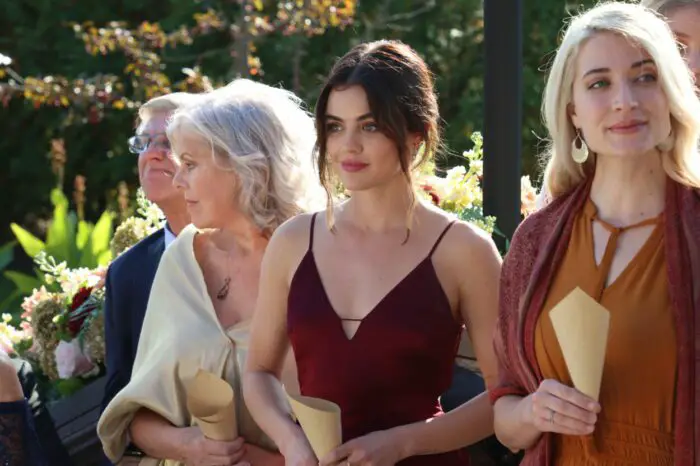Right from the get-go of the opening credits, the romantic dramedy Which Brings Me to You immodestly uses a soundtrack of modern covers of old Great American Songbook standards. There’s discerning wisdom in those choices from Then Came You director Peter Hutchings. In addition to employing his talented musical brother Spencer Hutchings to score all his films, Great American Songbook selections are always a classy rub of style. To boot, the best part of their thematic inclusion is what those old ditties say that most modern pop songs cannot nowadays.
Take Which Brings Me to You’s use of “It Had to Be You,” a 100-year-old standard, in the opening credits, sung with some swanky pep by Danielle Nicole and Davey Nate. The ballad’s lyrics telegraph where the film is going and welcomes the audience to that same journey. The key is the second verse:
Some others I’ve seen
Might never be mean
Might never be cross or try to be boss
But they wouldn’t do
For nobody else gave me a thrill
With all your faults, I love you still
It had to be you, wonderful you
It had to be you
The final four lines of that verse are repeated for the song’s outro, and it all hinges on “with all your faults.” Even though the film is based on the novel of the same name written by Steve Almond and Julianna Baggott, Which Brings Me to You knows what the song has known for a century. We root for imperfect and recovered love. Give us that and we’re in. Besides, the great song will place twice before the movie’s over.

The “Meet Cute” of Which Brings Me to You is the dashing sprint of a casual sex encounter. As soon as thirtysomething, flying solo wedding guests Will (Nat Wolff of Paper Towns) and Jane (The Hating Game’s Lucy Hale) lock eyes on each other when he arrives fashionably late to beachfront of Keansburg, New Jersey, the attraction is immediate and the game is on. Cutting through courtship BS, Jane suggests they immediately have sex in the coat room at the wedding. In the heat of the rushed passionate moment, Will wisely pumps the brakes with a line of “Hold on, can we talk for a minute?”
Jane is quick to counter that question with her own, “Can we not talk about our lives?” But Will is not taking no for an answer, leading Jane to leave in a huff unsatisfied and plenty embarrassed. Undeterred, Will tracks her down outside of the venue and convinces her to get a bite to eat at a local diner as the start of an apology.

Even with some greasy spoon food diluting Jane’s earlier liquid courage buzz, the small talk isn’t working. It doesn’t matter that Will is a commercial photographer and Jane is a freelance writer covering the New Jersey wedding scene. Nonetheless, he’s dying to learn more about this fetching woman. The conversational hook for Will that finally works to pique Jane’s intrigue is his urge to share the one sexual encounter of his life that was worse than the botched coat closet misadventure today. Naturally, she too has a story primed to top his.
These first two closet skeleton-exposing yarns embark Which Brings Me to You on a Linklater Lite path of walking-and-talking. What are they talking about to hit it off better than before? It’s not the typical flirty and self-promotional “getting to know you” small talk limited to basic likes, dislikes, and humblebrags. Instead, with starkly self-deprecating honesty, these two get frank and bare their souls on their many past romantic relationships.
As they do so, moments of remembered happiness often lead to an invading feeling of residual pain from old love wounds. In those revelatory confessions of first loves, worst heartbreaks, and the proverbial “ones that got away,” empathy grows. The two lift each other up as much as they are still evaluating each other’s newly revealed worth and recalculated romantic potential. As the night goes on, their bonding ties the two would-be strangers closer together in very “with all your faults, I love you still” acceptance and energy.

The back-and-forth stories shared by Will and Jane play out in lengthy flashback detail. The Which Brings Me to You script from talented animation storyteller Keith Bunin (Onward, Nimona) admirably expounds on these interesting mile markers of romantic reminiscence, often inserting the actors into their memories observing and narrating their old selves with an ensemble of suitors played by John Gallagher Jr. (Short Term 12), Genevieve Angelson (The Upside), Alexander Hodge (Joy Ride), and Britne Oldford (Free Guy). Throughout these many scenes past and present, both Wolff and Hale keep strong levels of allure. He has a sexy, toothless smirk and she has this affectionate blink move with her eye contact that simply melt you in your seat.
As Jane and Will’s mutual chapters get closer to their as-yet-unrevealed thirtysomething present situations, the chemistry between the actors increases. More importantly, the maturity of the romantic risks involved also increases. For a movie that started as hot-and-bothered as it did, the pendulum swing to dramedy heaviness of what’s really going on with these two in Which Brings Me to You is welcome and precarious at the same time. Like the leap the characters need to make to be better together, the 24-hour shorthand and 98-minute rush to pull it off is challenging and you miss the challenging humor.



